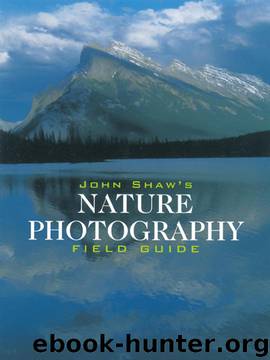John Shaw's Nature Photography Field Guide by John Shaw

Author:John Shaw [Shaw, John]
Language: eng
Format: epub
ISBN: 978-0-8174-0030-9
Publisher: Crown Publishing Group
Published: 2011-05-02T16:00:00+00:00
BRYCE CANYON NATIONAL PARK, EARLY MORNING, FROM INSPIRATION POINT.
A short telephoto lens let me isolate one section of the hoodoos in the Bryce amphitheater. Using a focal length of around 100mm kept the perspective relatively normal—about the same as our eyes. If you’ve never been to Bryce Canyon, you might find the scale of this photo deceptive. How big are those formations? Well, those are full-sized ponderosa pines growing among the hoodoos.
Nikon F3, Nikon 50–135mm lens, Fujichrome 50.
When you change your physical location, you change not only your perspective, but also the apparent relationship between elements within a scene. The distance between two objects appears to be much greater when one of them is close to you than when both are distant. For example, look down a long row of telephone poles that are spaced equally apart. The ones closest to you will seem to be a good distance apart, but as you shift your vision to the ones further away they appear to get closer together. Photographically this is often called “telephoto compression,” but that’s a misnomer since it has nothing at all to do with focal length. We use telephoto lenses to look at distant scenes, and things far away seem close together. Similarly, objects that are physically quite close to the camera position appear proportionally much larger than those far away. Think of those telephone poles again—the ones nearby appear quite tall while the ones far away seem to shrink in size. Telephoto lenses compress the scene; wide-angle lenses decompress it.
Knowing all this, you can use both perspective and lens choice to affect the viewer’s perception of a scene. These should be conscious, careful decisions on your part. By selecting your vantage point, you control your image’s perspective. If you use a wide-angle lens, you can effectively change the relationship between foreground and background elements, and expand the scene to encompass more within your view. If on the other hand you select a telephoto lens, you can pluck out one area for the viewer, stack the elements tightly together, and effectively condense the scene. The choices are yours to make, so long as you have a selection of lenses from which to pick.
Download
This site does not store any files on its server. We only index and link to content provided by other sites. Please contact the content providers to delete copyright contents if any and email us, we'll remove relevant links or contents immediately.
Shoot Sexy by Ryan Armbrust(17659)
Portrait Mastery in Black & White: Learn the Signature Style of a Legendary Photographer by Tim Kelly(16954)
Adobe Camera Raw For Digital Photographers Only by Rob Sheppard(16906)
Photographically Speaking: A Deeper Look at Creating Stronger Images (Eva Spring's Library) by David duChemin(16623)
Bombshells: Glamour Girls of a Lifetime by Sullivan Steve(13977)
Art Nude Photography Explained: How to Photograph and Understand Great Art Nude Images by Simon Walden(12975)
Perfect Rhythm by Jae(5326)
Pillow Thoughts by Courtney Peppernell(4211)
The Book of Joy by Dalai Lama(3903)
Good by S. Walden(3489)
The Pixar Touch by David A. Price(3366)
A Dictionary of Sociology by Unknown(3031)
Fantastic Beasts: The Crimes of Grindelwald by J. K. Rowling(2995)
Humans of New York by Brandon Stanton(2835)
Stacked Decks by The Rotenberg Collection(2812)
Read This If You Want to Take Great Photographs by Carroll Henry(2664)
On Photography by Susan Sontag(2576)
Insomniac City by Bill Hayes(2499)
Photographic Guide to the Birds of Indonesia by Strange Morten;(2490)
